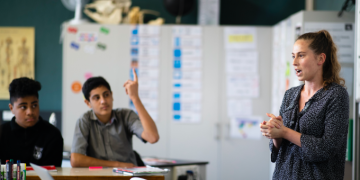How to use future briefs
to develop Financial Capability thinking. Future briefs are possible snapshots of the future of finance, identity and sustainability, set in an imagined New Zealand.







The future briefs are designed to be used as a problem-solving, group learning experience. Teachers can choose to use them as a one-off lesson to develop students’ problem-solving skills, and creative and critical thinking.
The process of undertaking the future briefs will make students aware of their values, thinking, skills, and behaviours about money/moni, financial identity, sustainability, and capability.
The future briefs support a problem-based approach to learning. Some of the design elements for this future-focused thinking can be attributed to the future-focus principle of The New Zealand Curriculum.
Each future brief is accompanied by a sound file, for greater accessibility to the material for all students.
Get started
Instructions
Groups: Teams of four students (maximum).
Teacher: Start by reading the text aloud and clarify new vocabulary or terms. Work on next steps with students who need assistance with the text. The text is also available as a podcast.
Need it/Know It
- Students read or listen to the future brief then highlight or note key phrases they think might be issues linked to personal financial management
- The teacher clarifies terms and vocabulary
- Students share the areas they highlighted and explain why to the wider group.
Link It/Think It
- Fold a large sheet of paper in half. On one side in the centre attach a future brief. Students use a marker pen or post-it notes to place comments around the future brief.
- The purpose is for them to identify information in the future brief and to explain why this information poses a problem or an issue. Focus on the negative effects at this stage. Students can identify information in the future brief that could affect their financial capability. Keep the students focused on this idea.
- Each future brief is accompanied by a question table from which students can generate ideas and discussion, and identify possible issues. Enlarge this table and have the students note their responses, then cut them out and position them around the future brief.
Extend it/Defend it
- Students record this one problem in the centre of the second half of the large sheet of paper with a circle around it
- Next, they write down as many solutions to this problem as they can come up with. All solutions must be ethical (this parameter can be decided by the students)
- Ask each student to select the solution they think is the best and which they think will have the biggest impact. Each member of the group then circles their best solution before voting for a group solution. If one solution doesn't win more votes than any of the others, the group can vote again for the contending winning solutions.
Once the students have decided on their group solution, they need to consider it carefully and run it through a filter to clarify their thinking. They can draw a table and consider their selected solution using these prompts:
Advantages:
- What are the benefits of our solution?
- What are the positive outcomes of our solution?
- What are the direct outcomes that could improve our financial identity/ sustainability?
Disadvantages:
- What could go wrong?
- How could this impact on our financial identity/ sustainability?
Outcomes
- The students create an annotated drawing. The whole group must contribute to the drawing. It should contain their big problem, their main solution, and key ideas, and it must make a link to financial identity or sustainability. The advantages and disadvantages must be included
- Students present their selected solution to the class
- There is no assessment matrix for this learning experience, but one can easily be co-constructed with students.



Download PDF
Māori Medium Education
Written in te reo Māori with resources aligned to Te Marautanga o Te Aho Matua and Te Marautanga o Aotearoa.

















